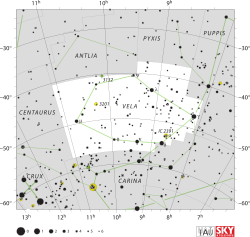Mu Velorum
| Observation data Epoch J2000 Equinox J2000 | |
|---|---|
| Constellation | Vela |
| Right ascension | 10h 46m 46.17877s[1] |
| Declination | –49° 25′ 12.9244″[1] |
| Apparent magnitude (V) | 2.69[2] (2.7 + 6.4)[3] |
| Characteristics | |
| Spectral type | G5III + G2V[3] |
| U−B color index | +0.57[2] |
| B−V color index | +0.90[2] |
| Astrometry | |
| Radial velocity (Rv) | +6.2[4] km/s |
| Proper motion (μ) | RA: +63.22[1] mas/yr Dec.: –54.21[1] mas/yr |
| Parallax (π) | 27.84 ± 0.38 mas[1] |
| Distance | 117 ± 2 ly (35.9 ± 0.5 pc) |
| Orbit[5] | |
| Period (P) | 138 yr |
| Semi-major axis (a) | 1.427″ |
| Eccentricity (e) | 0.84 |
| Inclination (i) | 57.0° |
| Longitude of the node (Ω) | 59.1° |
| Periastron epoch (T) | 1951.1 |
| Argument of periastron (ω) (secondary) | 178.0° |
| Details | |
| μ Vel A | |
| Mass | 3.30[6] M☉ |
| Radius | 13[7] R☉ |
| Luminosity | 107[3] L☉ |
| Surface gravity (log g) | 2.75[6] cgs |
| Temperature | 5,047[6] K |
| Rotational velocity (v sin i) | 6.4[6] km/s |
| Age | 360[3] Myr |
| Other designations | |
Mu Velorum (μ Vel, μ Velorum) is a binary star system in the southern constellation Vela. The two stars orbit each other with a semi-major axis of 1.437 arcseconds and a period of 116.24 years.[9] (Wulff-Dieter Heintz (1986) lists a period of 138 years with his orbital elements.)[5] The pair have a combined apparent visual magnitude of 2.69,[2] making the system readily visible to the naked eye. From parallax measurements, the distance to this system is estimated to be 117 light-years (36 parsecs).[1] The system is about 360 million years old.[3]
The primary component is a giant star with an apparent magnitude of 2.7 and a stellar classification of G5 III.[3] It is radiating about 107 times the luminosity of the Sun from an expanded atmosphere about 13[7] times the Sun's radius. The mass of this star is 3.3[6] times that of the Sun. In 1998, the Extreme Ultraviolet Explorer space telescope detected a strong flare that released an X-ray emission nearly equal to the output of the entire star. The quiescent X-ray luminosity of Mu Velorum A is about 1.7 × 1030 erg s–1.[3]
The fainter companion, Mu Velorum B, is a main sequence star with an apparent magnitude of 6.4[3] and an assigned stellar classification of G2V.[3] However, this classification is suspect. Closer examination of the spectrum suggests the star may actually have a classification of F4V or F5V, which suggests a mass of about 1.5 times the mass of the Sun. Such stars typically do not show a marked level of magnetic activity.[3]
References
- ^ a b c d e f van Leeuwen, F. (November 2007), "Validation of the new Hipparcos reduction", Astronomy and Astrophysics, 474 (2): 653–664, arXiv:0708.1752, Bibcode:2007A&A...474..653V, doi:10.1051/0004-6361:20078357.
- ^ a b c d Johnson, H. L.; et al. (1966), "UBVRIJKL photometry of the bright stars", Communications of the Lunar and Planetary Laboratory, 4 (99), Bibcode:1966CoLPL...4...99J.
- ^ a b c d e f g h i j Ayres, Thomas R.; Osten, Rachel A.; Brown, Alexander (November 1999), "The Rise and Fall of μ Velorum: A Remarkable Flare on a Yellow Giant Star Observed with the Extreme Ultraviolet Explorer", The Astrophysical Journal, 526 (1): 445–450, Bibcode:1999ApJ...526..445A, doi:10.1086/308001.
- ^ Evans, D. S. (June 20–24, 1966), Batten, Alan Henry; Heard, John Frederick (eds.), The Revision of the General Catalogue of Radial Velocities, University of Toronto: International Astronomical Union, Bibcode:1967IAUS...30...57E.
{{citation}}: Unknown parameter|booktitle=ignored (help) - ^ a b Heintz, W. D. (April 1986), "Orbits of 20 visual binaries", Astronomy and Astrophysics Supplement Series, 64 (1): 1–7, Bibcode:1986A&AS...64....1H. Listed as Ru 155.
- ^ a b c d e Mallik, Sushma V.; Parthasarathy, M.; Pati, A. K. (October 2003), "Lithium and rotation in F and G dwarfs and subgiants", Astronomy and Astrophysics, 409: 251–261, Bibcode:2003A&A...409..251M, doi:10.1051/0004-6361:20031084.
- ^ a b Mullan, D. J.; et al. (May 2006), "A Comparative Study of Flaring Loops in Active Stars", The Astrophysical Journal Supplement Series, 164 (1): 173–201, Bibcode:2006ApJS..164..173M, doi:10.1086/502629.
- ^ "CCDM J10468-4925AB -- Double or multiple star", SIMBAD, Centre de Données astronomiques de Strasbourg, retrieved 2012-02-03.
- ^ Hoffleit, D.; Warren, W. H., Jr. (1987), "The Bright Star Catalogue, 5th revised edition", Astronomical Data Center Bulletin, 1 (4): 285–294, Bibcode:1987ADCBu...1..285H.
{{citation}}: CS1 maint: multiple names: authors list (link)

